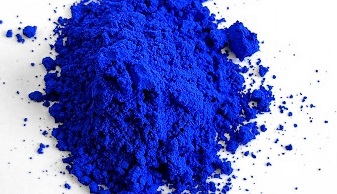As research for the exhibition Saturated: The Allure and Science of Color (May 11, 2018–January 13, 2019), the curators interviewed color specialists working in diverse industries and fields, from fashion forecasting to early childhood education. For our Careers in Color blog series, we asked these specialists to tell us about their work and how their love of color led to a professional career. Mark Ryan is a marketing manager for Shepherd Color Company.

Mark Ryan, Marketing Manager for Shepherd Color Company
What do you do?
Shepherd Color Company produces color pigments for the plastics and coatings market. For example, we supply pigments to paint manufacturers to color their paints. As marketing manager, my job is to assist in the development of new products, and to help bring those products to market. Developing new products involves all parts of our company—from research and development to production, regulatory compliance, technical services, and sales. I am always looking for better ways to communicate about color and the pigments used to make those colors.
How did you come to work in the color industry?
I have a bachelor’s degree in chemistry. I started out in the lab as a coatings chemist, developing coatings for aircraft. Later, I went back to school at night to earn my MBA, and switched to sales and marketing. What I do now is very different from working on a lab bench solving technical issues. Along with writing articles for industry publications, I have traveled all over the world representing Shepherd and our products.
What is color issue are you working on at the moment?
We are always looking for ways to more efficiently and sustainably make our pigments. We also develop new pigment chemistries to address color needs in a variety of industries. Determining how these new products fit into the market place, what advantages they bring to our coatings and plastics customers, and how they can be guided through a complex regulatory environment requires the attention of many highly trained people. Our “Holy Grail” is a high-performance, inexpensive, durable red pigment, which has remained an elusive goal. We continue to improve on our NTP Yellow and RTZ Orange pigments to help replace toxic pigments like lead chromate yellow, which is no longer approved for use.
Tell us about an impactful experience you’ve had with color. How has it influenced your work?
One meaningful experience involved working with a plastics company that makes gear for the United States military. We manipulated the infrared properties of our pigments so they could provide camouflage from enemy night-vision detection.
Another was working alongside building code and regulatory organizations to develop infrared reflective pigments, like our Arctic IR-reflective pigments. Used in roof, wall, and pavement materials, they have the potential to save energy and improve air quality in cities.
These examples are about invisible attributes of our pigments, but they show how color is important to the functioning of modern, innovative products. We need products like that to address the challenges facing our world.
Are there any color models or tools that you use regularly in your work?
Words are imprecise, and color is something that is especially difficult to communicate. Carrying physical samples of all the colors we produce isn’t really feasible. Like many other things today, we developed an app to address that. Our app for iOS devices allows you to view all the permutations of our color products, and to fly around them in a 3D-color space.
How does the process of government approvals for a new pigment work? Does it depend on the pigment’s end use (food, cosmetics, apparel, etc.)?
In order to commercialize a product, it must be listed on the federal government’s TSCA (Toxic Substances Control Act) Inventory. Other countries have similar requirements for commercial sales. but the approval process varies around the world. Getting all the testing done for the different approvals is a very big task. Approval for commercial sale is generally referred to as “registration.” Beyond that there are regulatory approvals for specific applications, like FDA (Food and Drug Administration) approvals for cosmetics or food packaging. Some are based on general chemical type while others are specific to a product. Some of the testing can be done in-house and some needs to be done by a third party. Regulations are increasing in complexity and are a major factor to consider when developing new products.
What kind of safety issues arise for different colors and why? Are there some that are dangerous to manufacture, but safe to use once completed and vice versa?
All materials need to be handled in appropriate ways based on their properties. The risk a material poses is based on the intrinsic hazard of the material and the exposure. For example, a pigment in dry powder form may be hazardous if inhaled, but once it is incorporated into a polymer, it is no longer available as a dust, eliminating the exposure risk. Workers who are exposed to the dry pigment form must wear proper equipment, like respirators.
Tell us about the new blue Shepherd is developing. What sorts of opportunities does it lend itself to and how is it different from other blues?
The YInMn blue is a great example of “old-school” science. It was discovered serendipitously by Oregon State University researchers who were trying to develop superconducting materials. In a “eureka” moment, they found that one material they made was a bright blue color. When OSU partnered with Shepherd Color, we found that the near-infrared reflecting properties gave it a distinct advantage over other products on the market (see above regarding the uses of our Arctic IR-reflective colors).
Do you create colors for businesses or work with them to select existing colors? Are you always trying to develop new colors, or do you respond to requests from industry?
Our specific strength is our expertise in durable pigments that are resistant to heat, ultraviolet light, and other environmental attacks. While many colors can be made, we have all seen materials that have been savaged by exposure to the elements. Shepherd Color is always looking for new pigments that will allow our customers to make plastics, coatings, and other materials in the shades that they want, and stay that color. For example, no replacement had the durability, chromaticity, and opacity of lead chromate yellow until the development of Shepherd Color’s NTP Yellow pigment.
